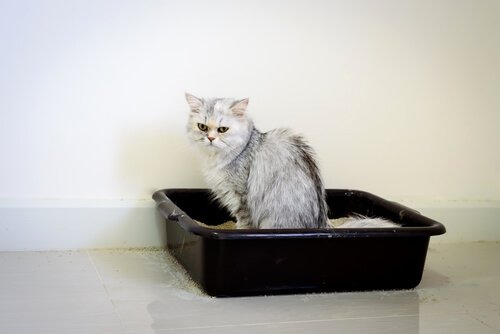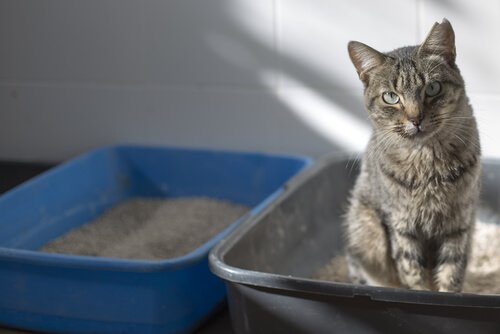Urinary Tract Infections in Cats

Cats are prone to certain bladder and kidney problems. So, it’s very important to know how to detect and treat them in time. In this article, we’ll tell you everything you need to know about urinary tract infections in cats.
What to know about urinary tract infections in cats
Urinary tract infections are very common in cats, and are quite bothersome and painful. Unlike dogs, cats don’t drink much water and their urine is more concentrated. Those are the main reasons why they are so vulnerable to infections.
The three most common urinary diseases in cats are : urolithiasis (urinary calculi), nephritis (kidney inflammation), and cystitis (bladder inflammation). Since the symptoms are very similar, sometimes people don’t know what it is until the vet runs a check up on their cat.
In order to tell if your cat has a urinary tract infection, you should pay close attention to certain symptoms. However, some cats don’t show any symptoms. Observe your pet’s behavior while he urinates or dedicates in the litter-box.

If a cat has a urinary tract infection, he will probably have force himself to urinate. urinate in very small quantities, go the bathroom outside the tray, or cry and meow while using the litter-box. In more advanced stages, blood can appear in the urine or may have a fever.
Detecting and treating urinary tract infections in cats
While these diseases can show up during any moment of your pet’s life, they are more common during adulthood or in obese cats. Urinary tract infections also happen to animals that live in very small spaces, are easily stressed, or have been sterilized.
To diagnose the problem, in addition to analyzing the symptoms, it’s very important to take the animal to the vet, because he/she will run different tests to evaluate the disease, such as blood tests and urine samples.
Treatment will depend on the type of infection and the cat’s traits. However, in most cases he will need antibiotics or other medications to relax the urethra and prevent new blockages from appearing in the urinary tract.
In some severe cases, the veterinarian may insert a catheter– with anesthesia– to enable the urine to flow easily, and then use an IV to provide fluids. Your cat may have to stay at the vet’s for at least two days.

Once the animal’s infection is treated, the next step is to prevent the problem from becoming chronic. You can do this by training your cat to drink more water so he can expel toxins from his body.
Check with the vet to find out what dry and wet foods are best for a cat with urinary problems. You can use recipes that don’t contain too much sodium, a component that doesn’t allow the kidneys to work well.
It’s very important to clean the litter box on a daily basis so the bacteria don’t multiply and cause infections. Make sure you give your cat a quiet, happy life to prevent anxiety or stress from making him sick.
Likewise, it’s a good idea to play more often with your cat so he can exercise and prevent having a sedentary lifestyle and obesity. Those two things are some of the worst enemies to your cat’s urinary health.
Make sure you tell your vet about any symptoms or changes in the animal’s behavior that are related to his usage of the litter box, that way the vet can analyze the situation better. Don’t wait for your cat to “get better on his own”, because that make the situation even worse.
Cats are prone to certain bladder and kidney problems. So, it’s very important to know how to detect and treat them in time. In this article, we’ll tell you everything you need to know about urinary tract infections in cats.
What to know about urinary tract infections in cats
Urinary tract infections are very common in cats, and are quite bothersome and painful. Unlike dogs, cats don’t drink much water and their urine is more concentrated. Those are the main reasons why they are so vulnerable to infections.
The three most common urinary diseases in cats are : urolithiasis (urinary calculi), nephritis (kidney inflammation), and cystitis (bladder inflammation). Since the symptoms are very similar, sometimes people don’t know what it is until the vet runs a check up on their cat.
In order to tell if your cat has a urinary tract infection, you should pay close attention to certain symptoms. However, some cats don’t show any symptoms. Observe your pet’s behavior while he urinates or dedicates in the litter-box.

If a cat has a urinary tract infection, he will probably have force himself to urinate. urinate in very small quantities, go the bathroom outside the tray, or cry and meow while using the litter-box. In more advanced stages, blood can appear in the urine or may have a fever.
Detecting and treating urinary tract infections in cats
While these diseases can show up during any moment of your pet’s life, they are more common during adulthood or in obese cats. Urinary tract infections also happen to animals that live in very small spaces, are easily stressed, or have been sterilized.
To diagnose the problem, in addition to analyzing the symptoms, it’s very important to take the animal to the vet, because he/she will run different tests to evaluate the disease, such as blood tests and urine samples.
Treatment will depend on the type of infection and the cat’s traits. However, in most cases he will need antibiotics or other medications to relax the urethra and prevent new blockages from appearing in the urinary tract.
In some severe cases, the veterinarian may insert a catheter– with anesthesia– to enable the urine to flow easily, and then use an IV to provide fluids. Your cat may have to stay at the vet’s for at least two days.

Once the animal’s infection is treated, the next step is to prevent the problem from becoming chronic. You can do this by training your cat to drink more water so he can expel toxins from his body.
Check with the vet to find out what dry and wet foods are best for a cat with urinary problems. You can use recipes that don’t contain too much sodium, a component that doesn’t allow the kidneys to work well.
It’s very important to clean the litter box on a daily basis so the bacteria don’t multiply and cause infections. Make sure you give your cat a quiet, happy life to prevent anxiety or stress from making him sick.
Likewise, it’s a good idea to play more often with your cat so he can exercise and prevent having a sedentary lifestyle and obesity. Those two things are some of the worst enemies to your cat’s urinary health.
Make sure you tell your vet about any symptoms or changes in the animal’s behavior that are related to his usage of the litter box, that way the vet can analyze the situation better. Don’t wait for your cat to “get better on his own”, because that make the situation even worse.
This text is provided for informational purposes only and does not replace consultation with a professional. If in doubt, consult your specialist.








